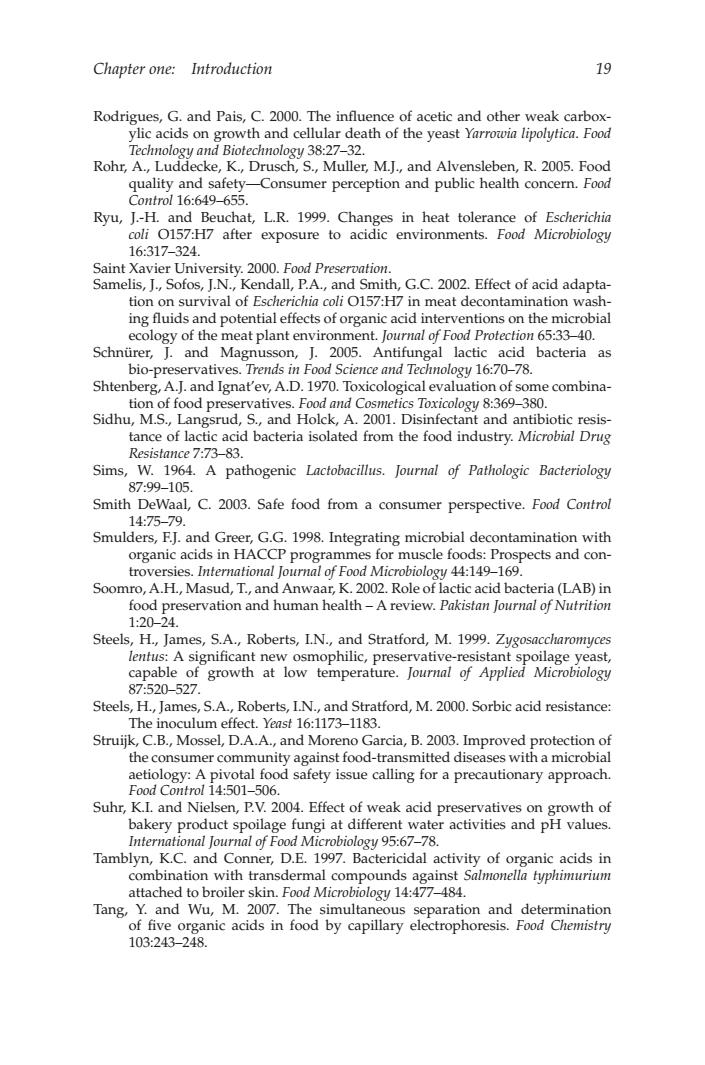正在加载图片...

Chapter one:Introduction 19 and Pais,C.2000.The inf 2Q. Rohr.ALuddecke.K Drusch.Alvensleben.R2005.Food quality and safety -Consumer perception and public health concern.Food C0 ntrol16:649-655 Ryu,J.-H.and Beuchat,L.R.1999.Changes in heat tolerance of Escherichia after exposure to acidic Saint y Samelis.Sofos,IN Kendall PA and Smith.G.C.2002 Effect of acid adapta tion on survival of escherichia coli o157-H7 in meat decontamination wash. ing fluids and potential effects of organic acid interventions on the microbial ecology of the meat plant environment.Journal of Food Protection 65:33-40. Schntirer,J.and Magnu on,J. 2005.Antifungal lacti bacteria as Shtenbe y16 8369-38 ecombina Sidhu.M.S..Lang ud.Sand Holck.A.2001.Disinfectant and antibiotic resis- tance of lactic acid bacteria isolated from the food industry.Microbial Drug Resistance 7:73-83 Smith DeWa 1450 C.2003.Safe food from a consumer perspective.Food Control Smulders,FJ.and Greer,G.G.1998.Integrating microbial decontamination with organic acids in HACCP programmes for muscle foods:Prospects and con- troversies.International Jouml of Food Microbiology 44:149-169 Soomro,A.H.,Masud,T.,and 2002.Role of and human tic acid bacteria(LAB)in istan Journal of Nutrition Steels,H.Ja lentus:A significant new osmophilic, capable of growth at low temperature.Journal of Applied Microbiolog 520-52 Steels,H.,James,S.A.Roberts,IN and Stra atford,M.2000.Sorbic acid resistance m D. and rcia,B.2003.Improve d oh: pivotal food safety issue calling for a precautionary approach Food Control 14:501-506. Suhr,K.I.and Nielsen,P.V.2004.Effect of weak acid preservatives on growth of bakery product spoila of Fo and pH values. 8 n with t cidal activit attached to broiler skin.Food Microbiology 14:477484. Tang,Y.and Wu,M.2007.The simultaneous separation and determination of five organic acids in food by capillary electrophoresis.Food Chemistry 103:243-248. Chapter one: Introduction 19 Rodrigues, G. and Pais, C. 2000. The influence of acetic and other weak carboxylic acids on growth and cellular death of the yeast Yarrowia lipolytica. Food Technology and Biotechnology 38:27–32. Rohr, A., Luddecke, K., Drusch, S., Muller, M.J., and Alvensleben, R. 2005. Food quality and safety—Consumer perception and public health concern. Food Control 16:649–655. Ryu, J.-H. and Beuchat, L.R. 1999. Changes in heat tolerance of Escherichia coli O157:H7 after exposure to acidic environments. Food Microbiology 16:317–324. Saint Xavier University. 2000. Food Preservation. Samelis, J., Sofos, J.N., Kendall, P.A., and Smith, G.C. 2002. Effect of acid adaptation on survival of Escherichia coli O157:H7 in meat decontamination washing fluids and potential effects of organic acid interventions on the microbial ecology of the meat plant environment. Journal of Food Protection 65:33–40. Schnürer, J. and Magnusson, J. 2005. Antifungal lactic acid bacteria as bio-preservatives. Trends in Food Science and Technology 16:70–78. Shtenberg, A.J. and Ignat’ev, A.D. 1970. Toxicological evaluation of some combination of food preservatives. Food and Cosmetics Toxicology 8:369–380. Sidhu, M.S., Langsrud, S., and Holck, A. 2001. Disinfectant and antibiotic resistance of lactic acid bacteria isolated from the food industry. Microbial Drug Resistance 7:73–83. Sims, W. 1964. A pathogenic Lactobacillus. Journal of Pathologic Bacteriology 87:99–105. Smith DeWaal, C. 2003. Safe food from a consumer perspective. Food Control 14:75–79. Smulders, F.J. and Greer, G.G. 1998. Integrating microbial decontamination with organic acids in HACCP programmes for muscle foods: Prospects and controversies. International Journal of Food Microbiology 44:149–169. Soomro, A.H., Masud, T., and Anwaar, K. 2002. Role of lactic acid bacteria (LAB) in food preservation and human health – A review. Pakistan Journal of Nutrition 1:20–24. Steels, H., James, S.A., Roberts, I.N., and Stratford, M. 1999. Zygosaccharomyces lentus: A significant new osmophilic, preservative-resistant spoilage yeast, capable of growth at low temperature. Journal of Applied Microbiology 87:520–527. Steels, H., James, S.A., Roberts, I.N., and Stratford, M. 2000. Sorbic acid resistance: The inoculum effect. Yeast 16:1173–1183. Struijk, C.B., Mossel, D.A.A., and Moreno Garcia, B. 2003. Improved protection of the consumer community against food-transmitted diseases with a microbial aetiology: A pivotal food safety issue calling for a precautionary approach. Food Control 14:501–506. Suhr, K.I. and Nielsen, P.V. 2004. Effect of weak acid preservatives on growth of bakery product spoilage fungi at different water activities and pH values. International Journal of Food Microbiology 95:67–78. Tamblyn, K.C. and Conner, D.E. 1997. Bactericidal activity of organic acids in combination with transdermal compounds against Salmonella typhimurium attached to broiler skin. Food Microbiology 14:477–484. Tang, Y. and Wu, M. 2007. The simultaneous separation and determination of five organic acids in food by capillary electrophoresis. Food Chemistry 103:243–248